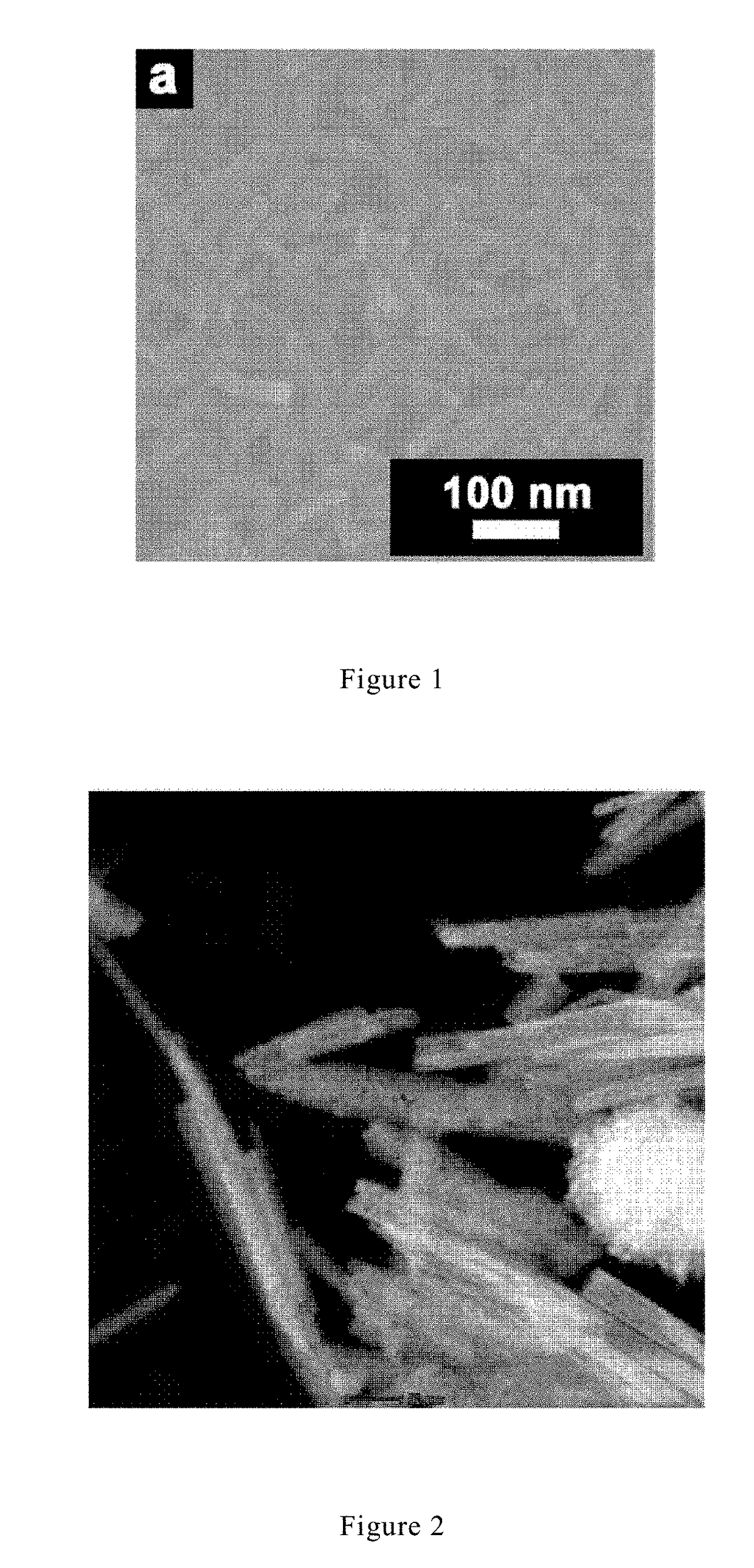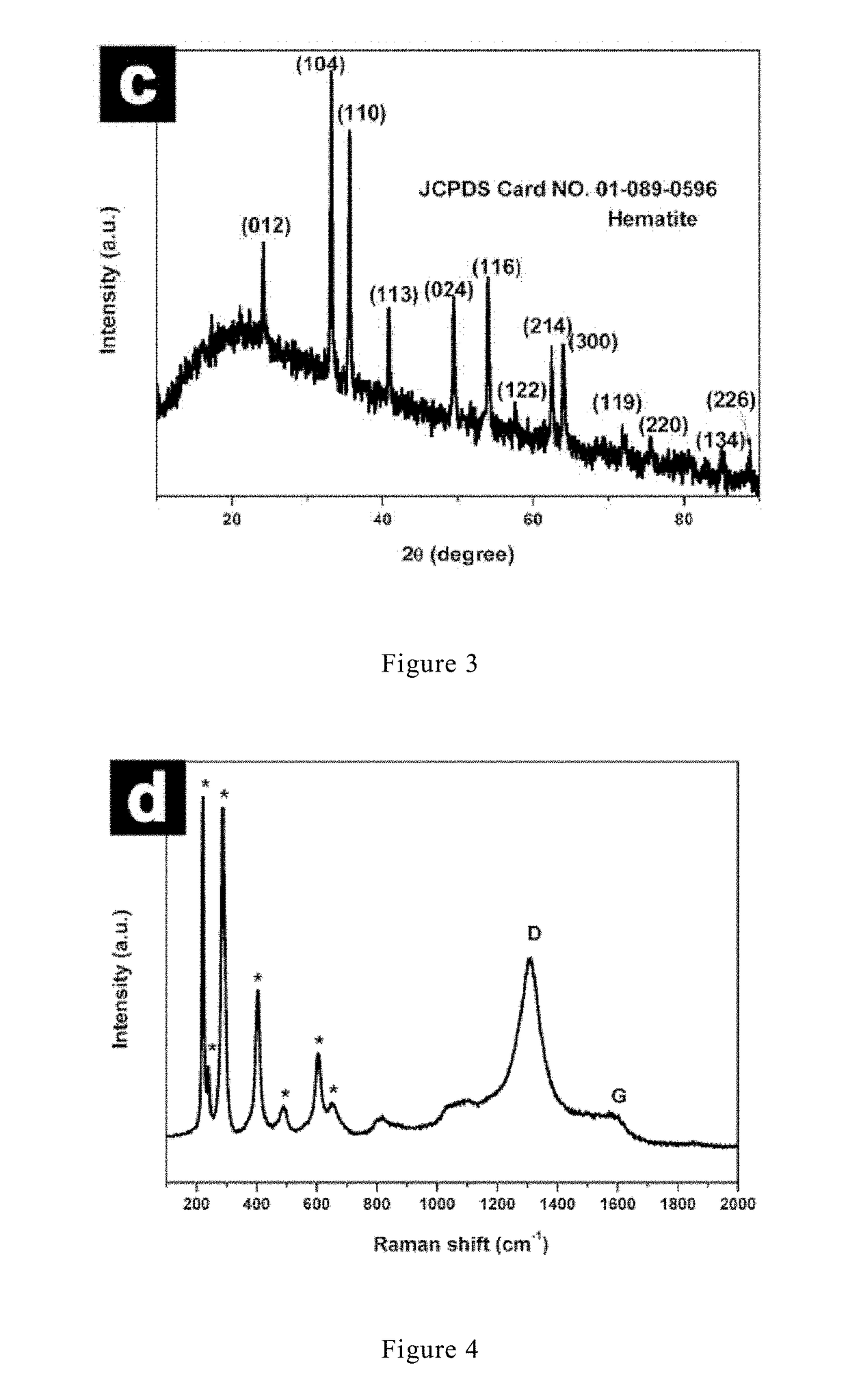Graphene/porous iron oxide nanorod composite and manufacturing method thereof
- Summary
- Abstract
- Description
- Claims
- Application Information
AI Technical Summary
Benefits of technology
Problems solved by technology
Method used
Image
Examples
embodiment 1
[0030]A method for preparing a graphene / porous iron oxide nanorod composite, comprises the following steps:
[0031](1) 0.05 g graphene oxide was mixed with 16 mL of fibroin solution of 5.06 wt %, pH was adjusted to 10, and 0.2 mL hydrazine hydrate was added to induce reduction, and a graphene-fibroin nanofiber composite was obtained;
[0032](2) 2.15 g FeCl3.6H2O was added into the graphene-fibroin nanofiber composite, and stirring was continuously until complete dissolution to get a mixture;
[0033](3) the mixture was poured into a reactor and reaction was carried out at 160° C. for 20 h;
[0034](4) after completion of the reaction, the resulting mixture was naturally cooled to room temperature, and the product was centrifuged, washed, and finally dried in vacuum to obtain a solid powder; and
[0035](5) the resultant solid powder was calcinated in a vacuum tubular furnace in an argon atmosphere at 400° C. for 5 h, and then was naturally cooled to room temperature to get the nanorod composite....
embodiment 2
[0037]A method for preparing a graphene / porous iron oxide nanorod composite, comprises the following steps:
[0038](1) 0.05 g graphene oxide was mixed with 0.19 mL of fibroin solution of 5.06 wt %, pH was adjusted to 10, and 1 mL hydrazine hydrate was added to induce reduction, and a graphene-fibroin nanofiber composite was obtained;
[0039](2) 1 g FeCl3.6H2O was added into the graphene-fibroin nanofiber composite, and stirring was continuously until complete dissolution to get a mixture;
[0040](3) the mixture was poured into a reactor and reaction was carried out at 120° C. for 36 h;
[0041](4) after completion of the reaction, the resulting mixture was naturally cooled to room temperature, and the product was centrifuged, washed, and finally dried in vacuum to obtain a solid powder; and
[0042](5) the resultant solid powder was calcinated in a vacuum tubular furnace in an argon atmosphere at 320° C. for 8 h, and then was naturally cooled to room temperature to get the nanorod composite.
[00...
embodiment 3
[0044]A method for preparing a graphene / porous iron oxide nanorod composite, comprises the following steps:
[0045](1) 0.05 g graphene oxide was mixed with 10 mL of fibroin solution of 5.06 wt %, pH was adjusted to 10, and 20 uμL hydrazine hydrate was added to induce reduction, and a graphene-fibroin nanofiber composite was obtained;
[0046](2) 3 g FeCl3.6H2O was added into the graphene-fibroin nanofiber composite, and stirring was continuously until complete dissolution to get a mixture;
[0047](3) the mixture was poured into a reactor and reaction was carried out at 200° C. for 8 h;
[0048](4) after completion of the reaction, the resulting mixture was naturally cooled to room temperature, and the product was centrifuged, washed, and finally dried in vacuum to obtain a solid powder; and
[0049](5) the resultant solid powder was calcinated in a vacuum tubular furnace in an argon atmosphere at 450° C. for 3 h, and then was naturally cooled to room temperature to get the nanorod composite.
[005...
PUM
 Login to View More
Login to View More Abstract
Description
Claims
Application Information
 Login to View More
Login to View More - R&D
- Intellectual Property
- Life Sciences
- Materials
- Tech Scout
- Unparalleled Data Quality
- Higher Quality Content
- 60% Fewer Hallucinations
Browse by: Latest US Patents, China's latest patents, Technical Efficacy Thesaurus, Application Domain, Technology Topic, Popular Technical Reports.
© 2025 PatSnap. All rights reserved.Legal|Privacy policy|Modern Slavery Act Transparency Statement|Sitemap|About US| Contact US: help@patsnap.com



